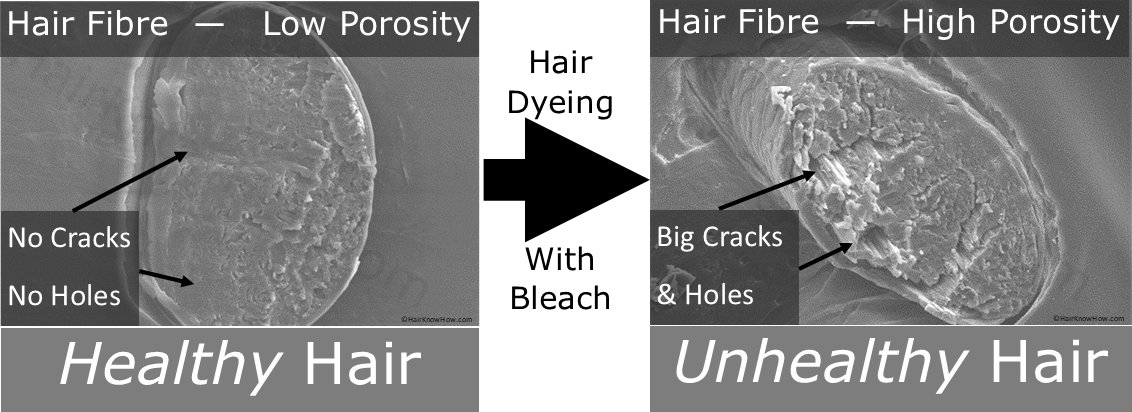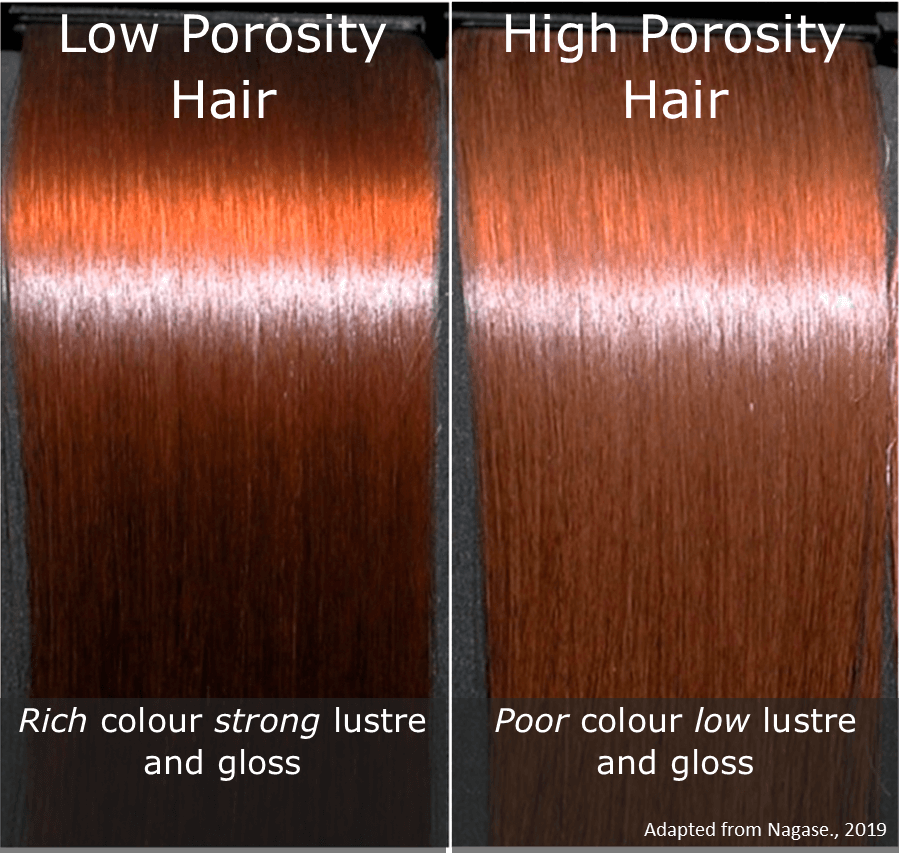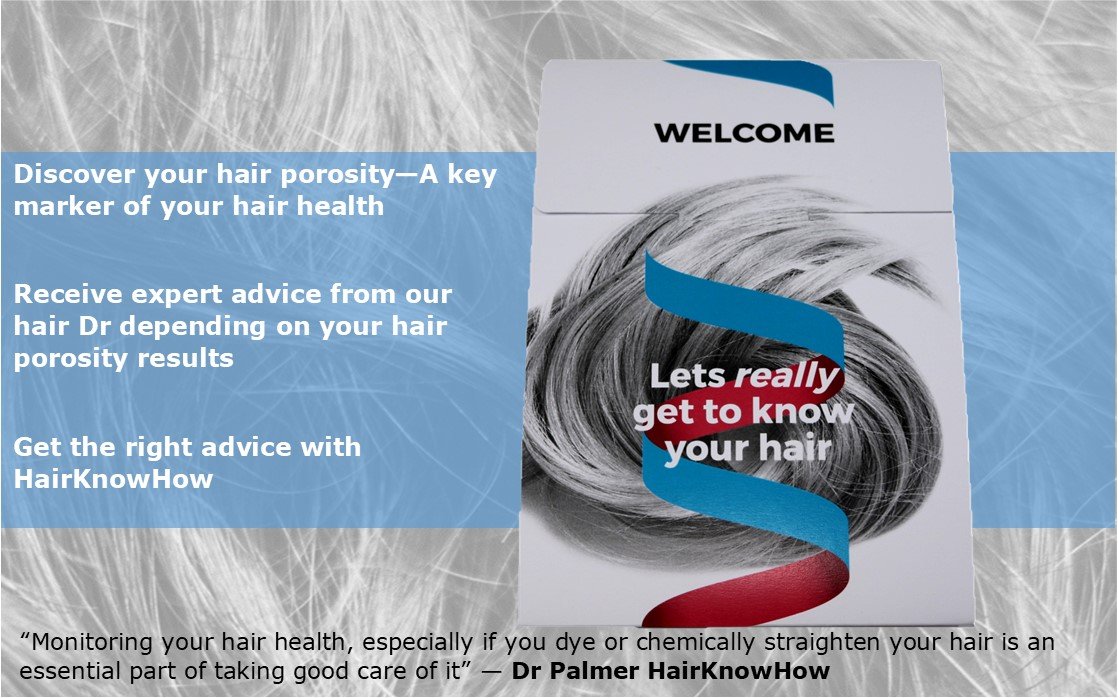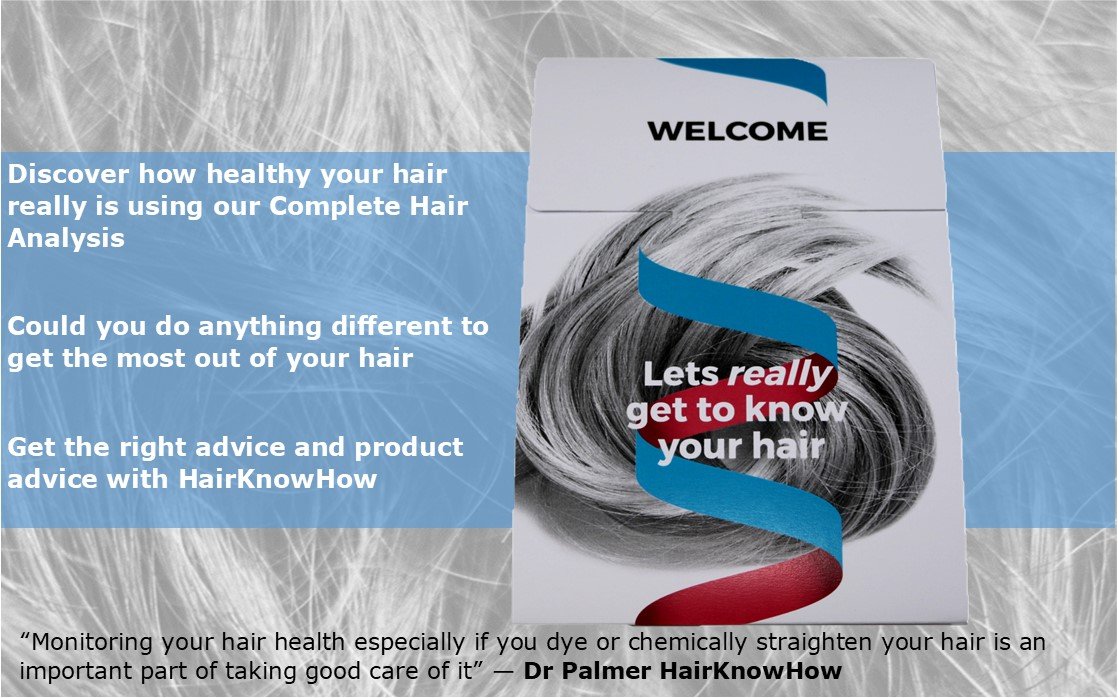Updated March 2023 By Dr Jonathan Palmer
Guide to Hair Porosity
What is porosity, and what increases your hair's porosity?
Hair porosity is quite simply a number (or metric) used to measure the number and size of holes within your beautiful hair.
Knowing your hair porosity is essential for all hair types and knowing this metric will help you better manage and get the best performance from your hair.
If you have high porosity hair, your hair is likely more fragile and prone to snapping. You could also experience increased mid-fibre breakage and split ends, reducing the natural rich deep colours possible with many hair types.
As an Amazon Associate, I earn from qualifying purchases - Click here to read our Affiliate Disclaimer
Book - Hair Structure and Chemistry Simplified, Fifth Edition
For further reading, we would recommend this book. It’s excellent and gives a great introduction to hair structure and science, boosting your knowledge of everything hair even further!
Typically, high porosity materials have holes and cracks varying in size, whereas low porosity materials have very few. The more holes and cracks or the larger they are, the higher the porosity. Put another way; porosity is essentially the ratio (or percentage) of the space within any material vs its total volume.
The scale of these holes and cracks within our hair can range significantly from the nanometers (nm – 1/10,000,000 of a cm) to many microns (µm – 1/10,000 of a cm) in size. They cannot be seen with our eyes alone, or even with many powerful light microscopes, requiring highly specialised electron microscopes (Scanning Electron Microscopes -SEMs or Transmission Electron Microscopes -TEMs) to see them.
Example of high porosity material– this stone has many small holes.
Example of low porosity material-These stones have very few or no holes in them.
Everyone's hair also has a porosity number, which can change over time, depending on many factors. For example, how long our hair is and whether we regularly chemically treat our hair with dyes containing bleaches such as hydrogen peroxide or chemical straighteners like ammonium thioglycolate or sodium thioglycolate. Regular use of other styling tools such as a flat-iron or curling-iron (curling tongs) when styling your hair can also increase its hair's porosity over time. This is because the high temperatures reached when using heating irons will boil any water within your hair, creating excess pressure within your hair fibres cortex, making any existing cortical holes or cracks larger. Excessive heating and subsequent degrading of the natural hair oils within your fibres can also create Reactive Oxygen Species (ROS) that can disrupt the disulphide bond network within your hair fibres cortex causing additional hair damage.
Our health and our hair's health are important to us. Almost everything we do to our hair, from our everyday grooming regimens, hair styling and colouring, will impact its porosity and general health in some way. Much of this damage will go unseen until we notice increased frizz, broken ends, hair breakage or decreased gloss and lustre. This is something we should all be trying to avoid.
As an Amazon Associate, I earn from qualifying purchases - Click here to read our Affiliate Disclaimer
Using sulfate-free shampoos and conditioners that contain either coconut and argan oil can help decrease the rate of porosity build-up in your hair. These are sulfate and silicone-free shampoo and conditioners we have used ourselves and recommend to everyone looking to experiment with sulfate and silicone-free shampoos. All Faith-In-Nature shampoos and conditioners are sulfate and silicone-free, with many products under their brand containing essential hair oils such as coconut oil, making them a very healthy and welcome addition to your hair regime. The Faith-In-Nature products we have tested have possessed, in our opinion, a very soft fragrance. Both are certainly worth trying if you are looking to move away from traditional shampoo and conditioning products towards more natural-mild ingredients. Let us know how you get on!
This doesn't mean that we cannot get the look or hairstyle we want, but we should all be aware of what we are doing to our precious hair and what the effects are, especially if our hair is relatively long (say greater than 15cm (6inches)). This is about the length our hair will grow in one year, and as we all know, we can do a lot to our hair over one year! Hair being an inert material, can't heal itself, so if damaged either physically or chemically, that damage will remain and accumulate until that fibre is naturally shed (falls out) as part of the follicle growth cycle or is cut off during a salon visit. So, we all should look after our hair as best we can. 😊
What are the main treatments to avoid if we want to keep our hair porosity low?
Our hair is most vulnerable to chemical attacks. We can do a lot physically to our hair, and it can be pretty forgiving, but the chemical attack is undeniably a real weakness when it comes to our hair. Specifically, we are referring to the use of peroxides and ammonia (ammonium peroxide and hydrogen peroxide), which are two very nasty chemistries used in everyday hair colouring. These chemicals have been shown to cause massive cuticle loss and increased hair fibre porosity leading to hair breakage, loss of lustre, and frizz requiring specialised treatment, including a possible reduction in hair length. Also, many people may not be aware that using these chemicals on your scalp will also damage your skin and skin follicles, increasing the risk of getting grey hair! This may sound crazy, but it is true.
We carried out some experiments with a sample of our own hair to show you the effects of hair colouring and bleaching. Take a look at the image and see for yourself what happens to your hair when you use bleach.
High-resolution images of healthy low porosity hair and unhealthy low porosity hair.
What having high porosity means for your precious hair?
We have seen that high porosity hair possesses many holes and cracks within many of the fibres. These holes and cracks are located within your hair fibres cortex, with the cortex being responsible for many of the critical properties of your hair. This includes our hair's colour because the cortex holds the melanin granules responsible for giving our hair its natural colour. Also, the bundles of keratin fibres that make our hair strong and give it its shape, curl and volume are present within and essentially make up the cortex.
The effect of high porosity hair can depend on the primary hair type you have. For example, hair snapping can happen much more readily if you have fine hair (Type A hair). You may also find increased difficulties keeping a style and a significant decrease in your hair's natural colour tone – meaning it will get lighter in colour. Those of you with coarse hair fibres (Type C hair) could find it is even harder to keep your hydration levels up, making your hair more fragile and resulting in increased hair breakage, a loss of hair volume and those rich deep colours characteristic with coarse hair types.
All hair types (from Type 1A to Type 4C) are essentially affected by high porosity. High porosity hair will reduce your total hair length, colour, lustre and increase broken ends and frizz. Increased hair breakage shortens your overall hair length. The loss of some of your colour pigments coupled with the holes in your hair's cortex can affect how light interacts within your hair fibres. This can result in an overall reduction in lustre and gloss, making your hair appear dull. The dull appearance is due to an increase in diffusive reflection phenomena. Increased frizz also helps create more tangles and knots, further increasing hair breakage during brushing, generally making your hair far less manageable.
The difference in hair lustre (how shiny your hair is) when comparing low porosity hair versus high porosity hair.
Now it is not all bad!
Firstly, we are sorry to create such a drab and bleak picture of high porosity hair. Still, the good news is that in the vast majority of cases, the problems associated with high porosity hair can be avoided. Simply by not chemically treating your hair or by minimising such treatments. We all want a different look and colour that often requires chemical straighteners and hair dyes, but the problems they can create can be pretty upsetting and cannot be repaired. Some hair repair products claim that they can repair high porosity hair damage, but these are primarily costly gimmicks and best avoided. Typically, the only proven solution to "repair" high porosity hair is to grow your hair out and cut off the damaged areas (usually the ends), resulting in removing the areas of damaged hair. This is not a quick-fix solution, but it is the only one.
As an Amazon Associate, I earn from qualifying purchases - Click here to read our Affiliate Disclaimer
We use these amazing hair masks ourselves. They make an excellent silicone-free alternative to conditioners that you can use every time you wash your hair. They are fantastic and give your hair a nutrient boost -precisely what it needs, with the oils need to help reduce the buildup of porosity. We use the coconut mask, which in our opinion, smells excellent and boosts hair health due to those all-important coconut oils. Let us know how you get on!
How do you get the most out of your hair if you have high porosity hair?
If you live with high porosity hair and want to make the best of the hair you have whilst growing it out, we would recommend using hair oils. Yes, this is something new for many people, and after all, why would you want to put something like Coconut oil or Argan oil in your hair?? These oils are good, not just because they are natural oils. We would recommend you use these oils because they have both been proven within the laboratory test environment (using multiple scientific techniques) to penetrate your hair fibres (and not just sit on the surface of the fibre). Importantly they have been shown to play a protective role in many different circumstances. After the absorption of hair oils such as Coconut oil and Argan oil within your hair fibres, they will help protect you from hygral fatigue -meaning they limit water swelling damage within your hair fibres. Hair oils will also help to reduce day to day hair damage when brushing or combing and help increase the glossy lustre appearance of your hair. There is even data within the scientific literature showing that Coconut oil and Argan oil has a protective effect against hair colouring chemistries. So if you are going to chemically colour treat your hair, then please have put a small amount of either Coconut oil or Argan oil on your hair before going to your salon.
Our quick guide to help you reduce the build-up of holes and cracks in your hair leading to high porosity
You can perform many little day-to-day tricks to help reduce the risks that lead to a build-up of hair damage culminating in high porosity hair.
Use a good shampoo, one that is ideally mild. What you want from a good shampoo is effective cleaning, but without completely removing or stripping the essential oils from within your hair. These natural oils within the cortex help protect your hair in so many ways. If in doubt, use less shampoo or dilute it slightly (by at least half) before use. We would also suggest that you shampoo for the least amount of time possible - get the shampoo on, quickly wash your hair, and then rinse it off. This will minimise the stripping of your hair, and importantly you can spend more time conditioning!
Use a good conditioner and one that ideally contains oils. Just be aware that many of the conditioners with oils will leave the bath or shower slippery, so take extra care. We would recommend conditioners that contain either Coconut oil or Argan oil. Both have been shown within a laboratory test environment to penetrate your hair fibres and importantly proven to decrease a great deal of damage caused by our day-to-day regimens, including brushing, shampooing, including some limited hair colouring and dyeing.
When showering, we recommend getting your chosen conditioner on your hair within 5 minutes of getting your hair wet. This is because it takes as long as 5 minutes for your hair fibres to swell (Learn more in our YouTube video) completely, and you can use this natural fibre swelling process to increase the amount of your conditioners nutrients and oils getting into your fibres cortex where they can do the best for your hair. This will help you get the full benefits of your conditioner long after you have dried your hair and in between conditioner applications.
Reduce hair dyeing frequency. If you can leave your hair for a little bit longer before returning to the salon for another colouring session, then please try. Your hair will thank you for it!
If you are dyeing your hair, try to use products that contain guanidine hydroxide instead of sodium hydroxide. Guanidine hydroxide is still very bad for your hair but causes around half the amount of hair damage as sodium hydroxide. Guanidine hydroxide is also slightly kinder to your scalp.
Try not to brush your hair when wet. Brushing your hair when wet causes significant damage to your cuticles. Also, your wet hair is much more prone to stretching, which can be irreversible and causes distortions and cracking within your cortex, increasing porosity.
Limit the use of straightening and curling irons if you can. The excessive heating of your hair can cause the rapid boiling of oils or water present within your hair. This heating can result in the subsequent expansion of any existing micro holes or cracks within your hair's cortex, increasing your hair porosity. One way to reduce the damage caused by hot irons is to turn down the heat on the iron to its lowest setting needed to achieve your desired style. This is only possible with many hot irons, but some new models allow the user to change the temperature - something we recommend you experiment with. Another alternative to hot irons is to use water or other styling products like mousses, hair wax, or styling hair sprays to get the look you are after. These are often kinder to your hair than direct heating, but we know their use does take more time and can be messy. Your hair will appreciate it. 😊
How to test your hair porosity at home – standard DIY methods we found on the web and HairKnowHow's thoughts on them.
There are many home DIY methods available that claim to help you determine your hair's porosity, but we believe they are all unreliable, with none of these tests being terribly accurate, scientific and only one (the strand test detailed below) being able to give you only a crude indication of your hair's porosity. For a more accurate and scientific assessment of your hair's porosity, we have developed a HairKnowHow porosity test as part of our hair analysis platinum service. If you really want to know your hair porosity level, we recommend using HairKnowHow's professional hair consultancy service.
As an Amazon Associate, I earn from qualifying purchases - Click here to read our Affiliate Disclaimer
These are two paraben and sulfate-free shampoos we have used ourselves and would recommend to everyone looking to experiment with excellent sulfate-free shampoos. They both contain good hair oils, either coconut or argan oil, making them a very healthy and welcome addition to your hair regime. Sulfates can increase the rate of porosity build-up if you have longer hair, so these sulfate-free shampoos could help. All OGX-branded shampoos have a thicker, luxurious, silky feel. This thicker consistency makes them easier to apply (compared to other sulfate-free formulations. They also possess a beautiful coconutty floral scent, in our opinion. The pH of both these shampoos was tested and found to be pH4.6. Both are definitely worth a go! Let us know how you get on!
The Hair Fibre Buoyancy Home DIY Porosity Test (HairKnowHow Rating: Three Stars Out of Five)
One of the most popular methods we found on the web is the hair-water sink, float test, or the Hair Fibre Buoyancy Test. This is the only DIY home method we would suggest using and is a method we tested to see if it worked (see results below!).
The Home DIY Buoyancy (Sink or Float) Porosity Hair Test
The Hair Fibre Buoyancy Home DIY Porosity Test:
Take a sample of your hair from your brush.
Wash your hair sample with some of your shampoo (oil-free and do not use conditioner!) and wait for it to naturally dry.
Place your dry clean hair into a clear glass of water, leave for approximately 5 minutes and see whether it sinks or floats.
Many websites claim that if your hair fibre floats after 5 minutes, it has low porosity, and if it sinks, then the hair fibre has high porosity.
To test this method, we measured the porosity of some of our chemically treated (excessively bleached) high porosity hair and compared it to a low porosity hair sample (determined using the HairKnowHow hair porosity test) to compare the DIY result with a proper scientific laboratory test. Before we started, both hair samples were washed with a commonly available shampoo (with no oils and no conditioner) and dried overnight. Both hair samples originally came from the same hair sample cut on the same day, making this a fair comparison.
We found that both the high porosity and low porosity samples floated initially, but over the course of 5 minutes, the damaged hair with high porosity did start to sink. This wasn't easy to see, as you can see in our video. The low porosity healthy hair sample did not sink and remained floating for the whole 5 minutes. In fact, after 9 hours, they were both still floating, with the high porosity damaged sample only having a couple of strands protruding into the liquid water. So, it did appear to work to a degree; however, the high porosity sample did not completely sink. We could visually see the difference because we could compare the results with two known hair samples. We would say it is worth ago for those of you at home, but it is very subjective and may be challenging to interpret. Also, the porosity rating of our hair sample was very high, so we would suggest that any subtle changes in the porosity of the hair sample would be challenging or maybe not possible to detect. So, the Hair Fibre Buoyancy Home DIY Porosity Test is primarily suitable for detecting either very healthy hair or very unhealthy hair only.
It is worth knowing that whether hair or any other material sinks or floats (we're talking about low-density materials like hair or feathers) is not just governed by the porosity of the material but also a combination with other important material properties, including their specific gravity (relative to water) and their innate surface or bulk hydrophobicity – i.e. how much they naturally repel water etc.
The Hair Wetting Duration Home DIY Porosity Test aka the Water Absorption Porosity Test (HairKnowHow Rating: One Star Out of Five)
This method requires that you take a shower and see how much time it takes for your hair to become fully wetted. The claim that accompanies this method is that if wetting takes a long time, your hair has low porosity, and if it absorbs the water very quickly, it has high porosity. No details are given about the amount of time it takes for the water to absorb or how you know when it is fully wetted. This method is very subjective, and we would recommend not using it at all. It is pretty confusing and not reliable. It is correct that damaged high porosity hair (lacking cuticle) will absorb water faster than undamaged hair, but you, the home DIY tester, would need a healthy hair sample of the same hair type to compare it to.
The DIY Hair Drying Porosity Test (HairKnowHow Rating: One Star Out of Five)
Fully wet your hair and body in the shower.
Allow your body and hair to air dry naturally, and note which dries first.
This porosity test requires that the experimenter fully wets their hair in the shower and allows their hair and body to air dry. Many websites say that if your body dries first, you have high porosity hair, and if your hair dries first, you have low porosity healthy hair. In our opinion, this method is not reliable at all. The drying rate for both your body and your hair will depend on many variables. These include the humidity of the environment you are in, how much hair you have, your hair type, the velocity of the air around you and many more.
In our opinion, the DIY Hair Drying Porosity Test is not worth performing. We have carried out some laboratory test experiments on hair drying. Indeed, high porosity hair takes longer to dry than low porosity hair, but this can only be seen by comparing damaged hair to undamaged hair. Comparisons of your hair drying with the drying of your body are not appropriate.
The Strand Test To Evaluate Hair Porosity (HairKnowHow Rating: One Star Out of Five)
Using one hand, pull some of your hair straight out in front of you.
With your other hand, close your thumb and index finger around the end of your hair and slide them up towards your scalp.
If your hair texture feels somewhat consistent, your porosity is low or 'normal'. But if your hair feels rough or possesses different areas of texture, then you may have high porosity hair.
This method claims that you are testing your hair's porosity. You are not. You are in fact-checking the consistency and roughness of your cuticle. We suggest that assessing the texture and consistency of your hair's cuticle or the exterior of your cortex (if you've lost your cuticle) would require some skill and training, ideally with known hair standards to compare to. The feel of your cuticle depends on many factors and can change if you are putting suitable good oils on your hair. With this method, no discernible information about your cuticle is obtained, making any changes in your hair's condition very subjective.
Image of healthy and unhealthy cuticle for comparison
It is well known that the health of your hair's cuticle is highly related to the health of the cortex of each individual fibre. However, the Strand Test cannot be used to check your hair's porosity. We would suggest that you use the Strand Test not to judge your hair porosity but to feel the direction of the cuticle scales of your hair fibres. Not many people realise that their cuticles effectively point away from their scalp. This is one of the reasons we brush our hair in the downward direction (away from our scalps) and why we feel resistance when moving our fingers through our hair from the fibre ends towards our scalps.
How would HairKnowHow suggest that you check your porosity?
We believe that none of the above DIY methods gives you any meaningful information about your hair porosity that you can use to make informed decisions about your hair. We would recommend that you get a simple hair porosity test from HairKnowHow. We expertly and scientifically evaluate your hair using the latest scientific hair tests, including evaluating your hair porosity. All of this information is assessed by our expert hair practitioners and reported to you in your very own personal hair report, including recommendations on how to get the best from your hair. Only when you really know your hair can you get the best hair care. HairKnowHow shows you your hair in a whole new way and works with you to get the most out of your individual hair's beauty and health performance.
Give HairKnowHow a hair test a try.
If you have any questions or comments, then please contact the HairKnowHow team and we’ll get back to you.
The Hairknowhow team. 😊








